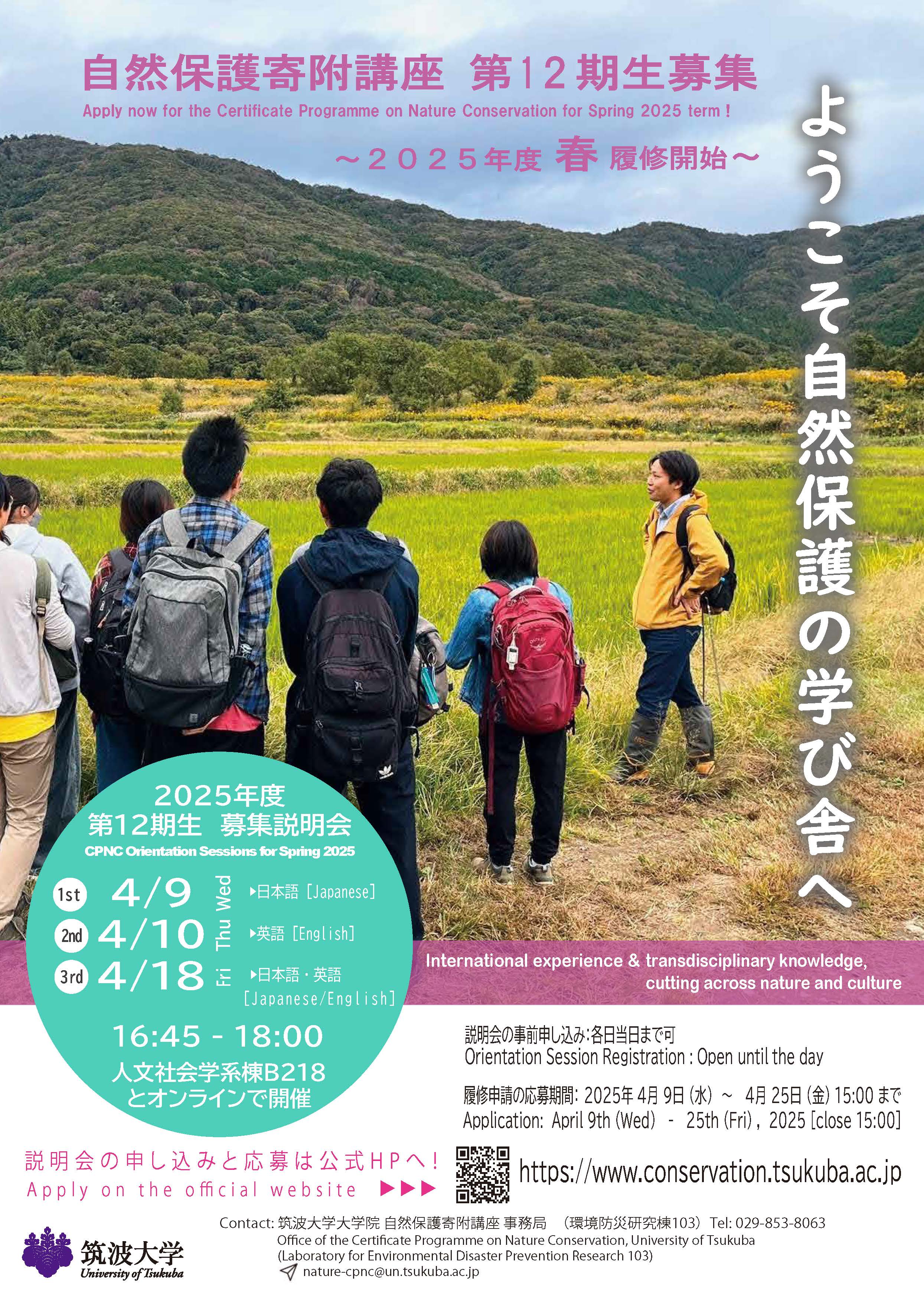筑波大学大学院新入生の皆さん、ご入学おめでとうございます!
自然保護寄附講座では、第12期生(2025年度春履修開始)を募集します。
Apply now for the Certificate Programme on Nature Conservation of 2025 (Spring Semester)!
自然保護にかかわって国際的に活躍したい人、自然保護と地域貢献を融合させたい人、自然保護とビジネスを結びつけたい人、ネイチャーポジティブ社会のデザインに興味のある人など。幅広い学生の興味に応えるため、講義、実習、インターンシップ派遣などを通じて様々な機会を提供します。
The CPNC offer opportunities, through lectures, practical courses and internship support, for students who wish to work in the field of global nature conservation, contribute to local society from nature conservation, link between nature conservation and business, and design nature positive society etc.
国際機関での実務や国際会議参加に関わるインターンシップ支援制度もあり、海外経験を得るチャンスもあります!
The CPNC students can have a chance to acquire a global and practical experience using the support system of internship for international organizations and conferences.

まずは説明会にご参加ください!
Before your application, please participate in CPNC Orientation Sessions!
【2025年度第12期春募集説明会/CPNC Orientation Sessions in Spring 2025】
説明会は3回開催します。
The session will be held three times.
次のフォームより事前申し込みのうえご参加ください(締切:各説明会当日の12:00) 。
Please register in advance using the form below (Deadline: 12:00 noon on the day of each session).
https://forms.office.com/r/M0z9AhhQAW
当日はいずれもハイブリッド (対面+ Teams)で開催いたします。
Each session will be conducted in a hybrid format (in-person + Teams).
人文社会学系棟 B218教室にお越しください。
Please come to Room B218, Humanities and Social Sciences Building.
https://maps.app.goo.gl/BrRc2fGiQt14y4nF7
オンラインをご希望の方は該当日のURLよりご参加ください。
If you would like to attend online, please join via the Teams link provided for the respective date.
■開催日時/Date and time
第1回 4月9日(水)16:45-18:00 [日本語]
1st 9 Wed April, 16:45-18:00 [ Japanese]
https://teams.microsoft.com/l/meetup-join/19%3ameeting_ZGU3OGQ2MTMtOTJjZS00ZjZhLTk0ZTktMGRiNTQ3NmMzMDk0%40thread.v2/0?context=%7b%22Tid%22%3a%229e5b5dfd-669d-4ef8-b240-4229cbf4a83d%22%2c%22Oid%22%3a%222df93a95-18c6-44bb-968b-8c8a0e4959ae%22%7d
第2回 4月10日(木)16:45-18:00 [英語]
2nd 10 Thu April, 16:45-18:00 [ English ]
https://teams.microsoft.com/l/meetup-join/19%3ameeting_ZGU3OGQ2MTMtOTJjZS00ZjZhLTk0ZTktMGRiNTQ3NmMzMDk0%40thread.v2/0?context=%7b%22Tid%22%3a%229e5b5dfd-669d-4ef8-b240-4229cbf4a83d%22%2c%22Oid%22%3a%222df93a95-18c6-44bb-968b-8c8a0e4959ae%22%7d
第3回 4月18日(金) 16:45-18:00 [日本語・英語]
3rd 18 Fri April, 16:45-18:00 [ Japanese / English ]
https://teams.microsoft.com/l/meetup-join/19%3ameeting_NTNlNzhlOTgtZTBiMC00Y2EzLTg4MmUtMjEzN2Q3YmQ5NmUy%40thread.v2/0?context=%7b%22Tid%22%3a%229e5b5dfd-669d-4ef8-b240-4229cbf4a83d%22%2c%22Oid%22%3a%222df93a95-18c6-44bb-968b-8c8a0e4959ae%22%7d
【 履修申請手続き/Application procedures 】
■応募期間 2025年4月9日(水)~ 4月25日(金)15:00
Application period: From 9 April, Wednesday to 25 April, Friday [close 15:00], 2025
■申請方法/How to apply
1. 研究指導教員に履修許可を得た上で、以下の履修申請フォームに必要事項を入力して応募してください。Please make sure to get your academic advisor’s approval before filling out the application form.
2. 指導教員の署名・押印済みの応募確認書を提出してください。応募確認書は面接時に持参するか、面接までに下記のFormsのリンクから書類をアップロードして提出ください。面接は5月7〜9日の間に行います。
You’ll also need to bring a course permission form with your advisor’s signature or seal to the interview or upload the document from the Forms link below and submit it before the interview. Interviews will be held between May 7 and 9.
2025自然保護寄附講座_応募確認書 Permission Form to apply for the CPNC2025.docx
Link to forms for upload https://forms.office.com/r/gz8MxzuHV3
3. 面接の日時は個別に連絡します。Interview dates and times will be announced individually.
■募集定員/The number of students to be admitted
30名前後/About 30 students
■履修要件 / Requirements
理工情報生命学術院生命地球科学研究群または人間総合科学学術院人間総合科学研究群世界遺産学学位プログラムに在籍している者
For students in Degree Programs in Life and Earth Sciences, Graduate School of Science and Technology or Master’s Program in Heritage Studies, Degree Programs in Comprehensive Human Sciences, Graduate School of Comprehensive Human Sciences only.